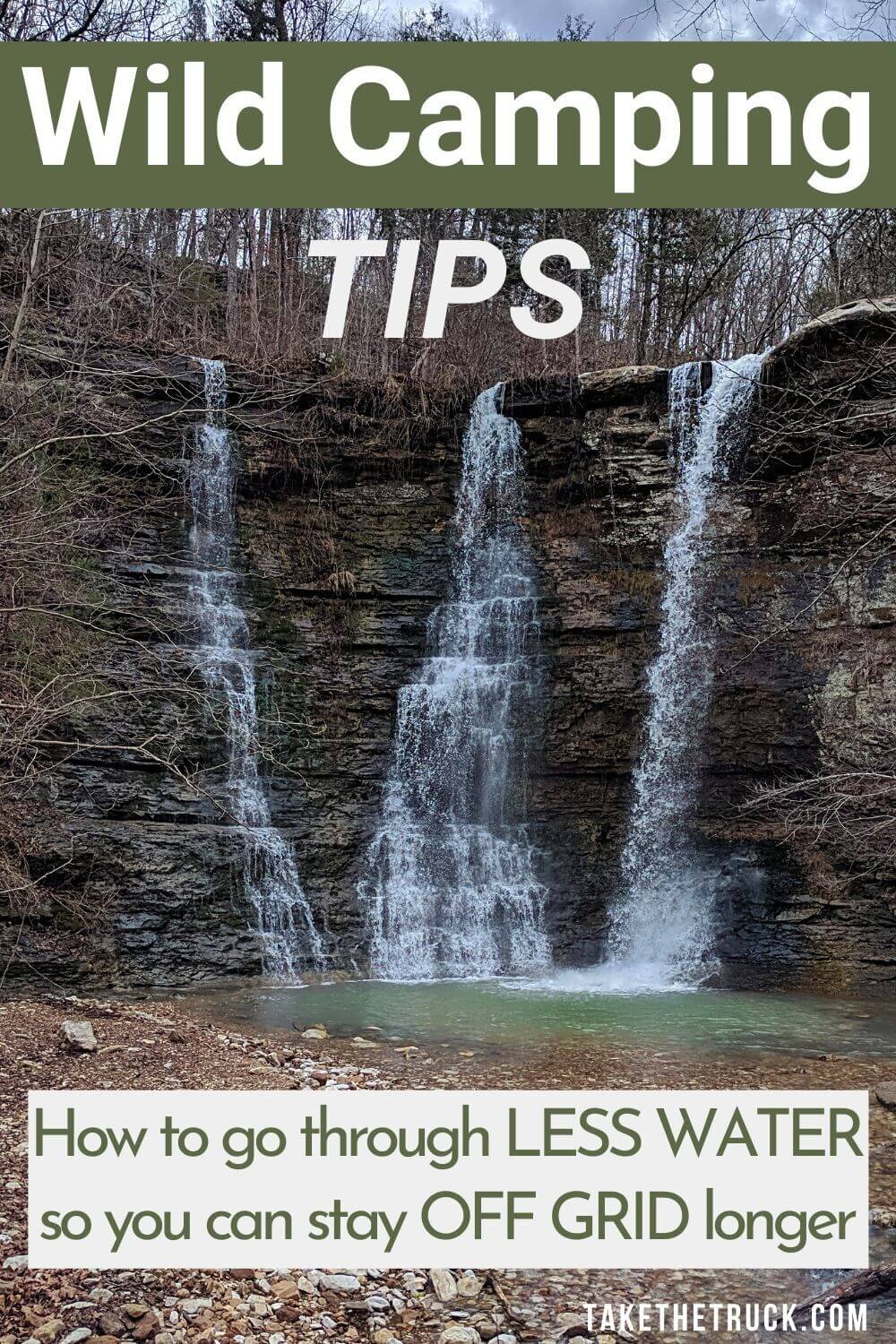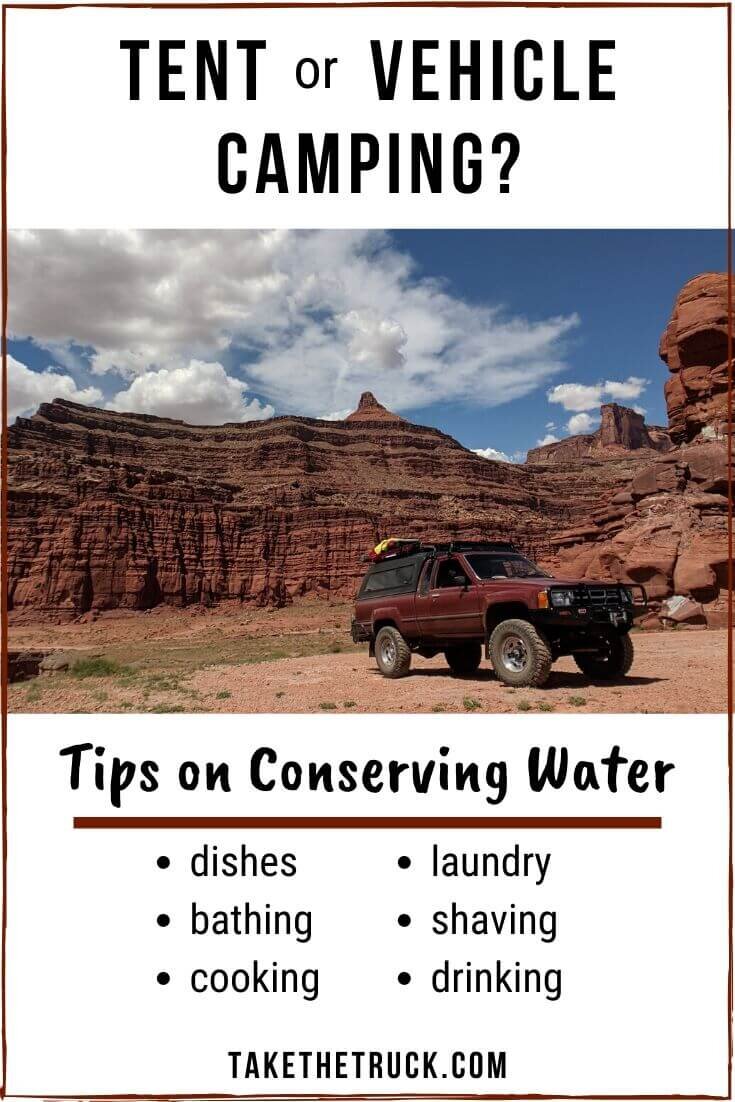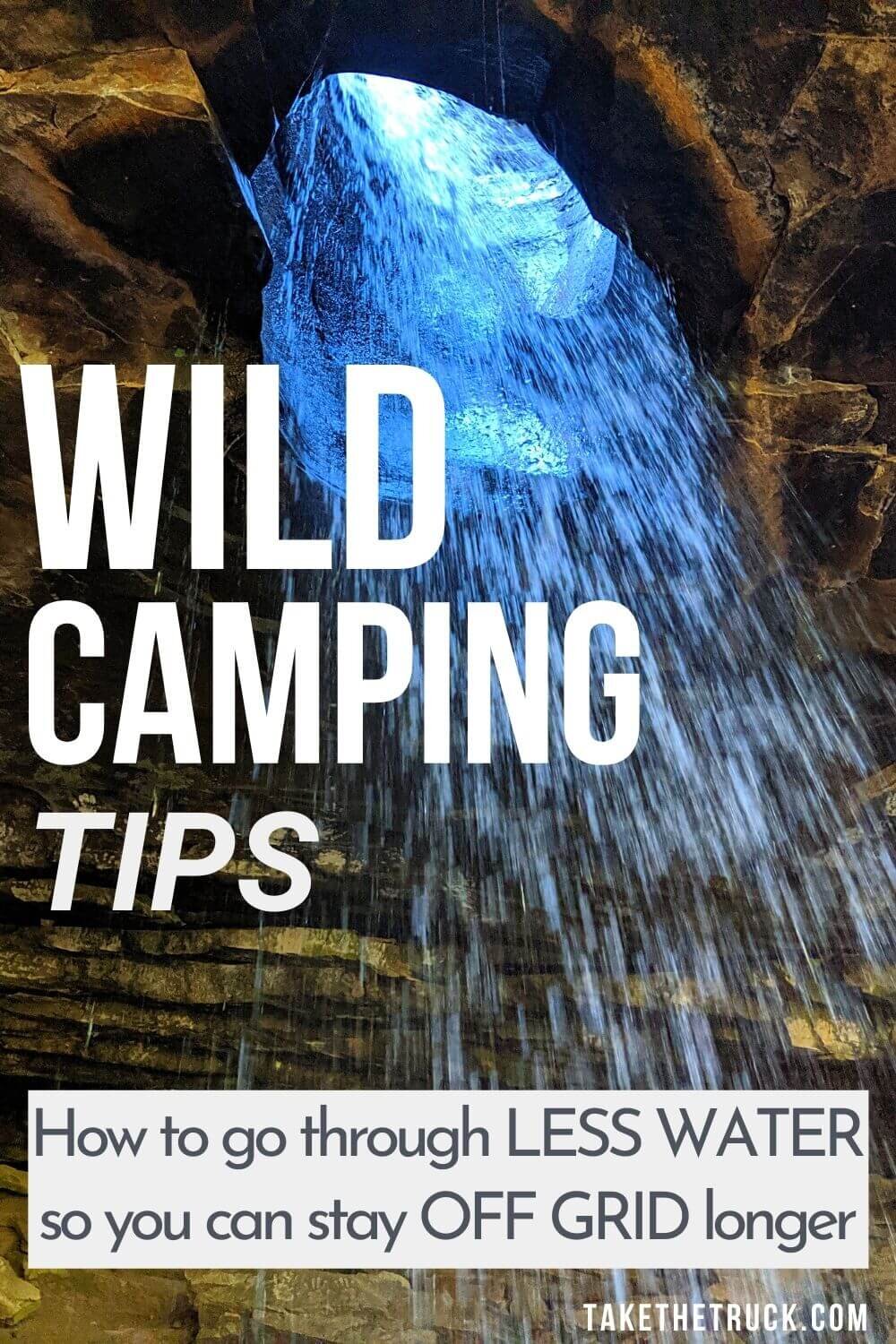How To Conserve Water While Wild Camping or Overlanding
By looking for places to go wild camping or dispersed camping while overlanding, you can save a TON of money and have an opportunity to explore new places off-the-beaten-path.
However, having no access to water, electricity, trash services, or other amenities means you’ve got to be completely self-sufficient.
Camping like this takes practice. And managing your water supply is a very crucial component to enjoying your wild camping or overlanding adventure. So in this post we’ll teach you all of the water conservation tips we’ve learned to better manage your water on you’re next trip!
*(This post contains affiliate links. This means we may receive a small commission, at no additional cost to you, if you make a purchase through a link. See our full disclosure.)
If you’re tent camping, vehicle camping, or overlanding you’re likely carrying a very limited water supply.
Personally, our main camping water container was the 7 gallon Roadshower, before we made a nice DIY water container/camping shower combo that holds 10 gallons - but this is still a small amount of water for three people.
So if you want to be off-grid wild camping for more than a day or two, you’ll need to find some ways to make it last.
Conserving Water When Wild Camping & Overlanding
Here’s a handful of water conservation tips, some a little more extreme than others. Pick and choose what you’re comfortable with and what will work for you!
Washing Your Hands
Use hand sanitizer* when appropriate while wild camping or overlanding
Dr. Bronner’s Castile Soap* does a good job of cleaning, is biodegradable, and also rinses off easily, using less water
Washing Your Face
Consider trying out no rinse face wipes* instead of face wash which requires more water to rinse
Showering/Bathing
There is no reason to stink or skip cleaning yourself while wild camping or overlanding!
Check out our post all about bathing options while wild camping
Less sweat, means less stink, means less showering - hike or do other more strenuous activities in the mornings and evenings when possible and pace yourself.
Wear a merino wool base layer and merino wool socks that naturally minimize body odor (or use synthetic clothing with an antimicrobial treatment - no cotton)
Use baby wipes, small sized wipes* designed for adults, and large sized body wipes* in between showers/sponge baths with water.
If you have a portable camp shower, install a shut off valve and take navy showers (stopping the water flow while lathering, and resuming the water flow for rinsing)
Washing Hair
If you have long and/or thick hair, having to wash it when trying to conserve water can be a real bummer.
Wash your hair when you have access to public showers (day-use area at a campground, etc), or in a river with biodegradable shampoo*.
Build up the number of days you can go between washing your hair. Consider trying out the no pooh method!
Cover it up! To both keep it cleaner and hide your mop - ponytails, buns, hats, etc. are all great options.
Use a dry shampoo* to stretch until your next public water source.
Quality boar bristle brushes* do a great job of distributing oils away from your scalp - going through the method of ‘scritching and preening’ in the evening can make your hair look and feel much cleaner by the next morning (check out Step 2 here if you want more info).
Shaving
Don’t. Ha, that’s easy!
Consider an electric razor*
Fill a cup with hot water to rinse your razor rather than putting it under running water
Brushing Teeth
Skip wetting your toothbrush first
One quick rinse of the toothbrush and a mouthful of water is all it takes
Laundry
Wear merino wool clothing or synthetic material to cut down on the amount of laundry (example - we comfortably wear our merino wool socks for at least 3 days of hiking and activity before washing).
Hang day old clothing up overnight to air out and freshen up (but not where you sleep because they’ll absorb the condensation you’re creating throughout the night!)
We love our Scrubba Wash Bag* for doing laundry while camping and traveling (here’s our post all about it)
Do laundry when camped next to running water (river, creek, etc) - having an endless supply of water on laundry day helps a TON
Use biodegradable soap (we love Dr. Bronner’s Sal Suds* - its concentrated so goes a long way)
Some may just make due, and only do laundry when a laundromat is available
Doing Dishes
Use a baby wipe or paper towel to get the majority of food off dishes first
Eat out of the pans you cooked in when appropriate
Use disposable plates - one tip we don’t like to turn to but do when in a pinch
If you have left-over water from boiling pasta, cooking rice, or making coffee don’t dump it out. Use it to soak a messy pan while you eat.
Try to plan no-mess food, one pot meals, or campfire meals to cut down on the kitchen mess
Caste iron* is our go-to because it takes much less water to get clean (this specific set doubles as a dutch oven!)
A spray bottle* with soap and water, and another with just water can come in handy for a lot of kitchen/bathroom needs while camping
When actually doing dishes, use a collapsible tub* or camping sink filled with an inch or so of hot soapy water to clean your (pre wiped) dishes, starting with the cleanest to the dirtiest, then use a little more water to rinse
Use a biodegradable dish soap (like Dr. Bronner’s Sal Suds) so the grey water you produce can be poured on the ground
Cooking Water
Don’t plan to cook things that require a bunch of water (example - quinoa or couscous takes much less water than required for boiling pasta)
Reuse cooking water to soak dirty pans when possible
Drinking Water
Carry a larger water bottle* for each person
At every gas station, rest stop, etc, fill them up!
Drink your fill while at a place with potable water, then leave with your water bottle full
Random Water Needs
When you find an clean bathroom at a deserted rest stop that has warm running water, use it! Just clean up after yourself.
Thoroughly wash contact cases, reusable water bottles, etc
Take care of any upcoming needs/wants you have that require water
Fill a collapsible tub to rinse off dirty gear (for us this is often our hitch mounted fridge)
AND - again, clean up after yourself before leaving!
Finding Potable Water When Wild Camping & Overlanding
Despite all your best efforts, eventually you’re going to run out of water in your camping water container. And when that happens, you’ll need a fill-up plan.
Carry a Water Filter
One of the best solutions is to carry a water filter you can count on. We used several options over the years with mixed results, before we finally decided to invest in the MSR Guardian - and we highly recommend it! This will allow you to turn almost any stream, river, lake, or pond into a source for safe potable water while wild camping or overlanding
Places to Find Potable Water
Here’s a list of places you’ll likely find potable water, often for free or sometimes for a small fee:
Of course, you can take water out of a nearby stream or other body of water if you’ve got a filter you can trust. After some bad experiences with cheaper filters over the years we landed on this one*.
National Parks
State Parks
City and County Parks
BLM and Forest Service Stations - water is usually available for backpackers so just ask
Rest Stops
RV Dump Stations - https://www.sanidumps.com/ and https://rvdumpsites.net/ are great for locating these spots
Gas Stations such as Flying J, Pilot - if you don’t see any potable water, just ask
Any Business you Visit - oftentimes just asking will do the trick, even in unusual places like restaurants or hardware stores
Gear to Help You Access Potable Water While Wild Camping or Overlanding
Below are a few pieces of gear you can carry with you on your wild camping or overlanding trips to help you more easily access potable water while traveling.
Collapsible Water Hose
A 25ft or 50 ft collapsible hose is great for transferring water into your camping water container from a spigot or water source at a distance. Plus they roll up into a much more compact form factor than traditional hoses.
Exterior Water Faucet & Sillcock Key
An exterior faucet & sillcock key is also a great tool to carry with you, it’ll allow you to access water spigots on the exterior of buildings in an emergency situation.
Camco Water Bandit
Carrying a Water Bandit with you on your wild camping or overlanding adventures will allow you to hook up a collapsible water hose to any type of spigot or sink faucet to get potable water into your camping water container.
Wild camping can be intimidating at first. But with a few failed attempts, more practice, and some determination, we think you’ll find camping without hookups to be really rewarding!
Hopefully these tips on conserving water when you’re out can help you feel more confident in getting out there and trying it. Or if you’re an old pro, maybe a few of these tips can help you stretch your water just a bit further.
And we’d love to hear any water conservation tips you have in the comments section below that might help keep us off grid just a little longer too!
As always, thanks for reading, and please SUBSCRIBE for blog updates.
Related Posts:
Wild Camping Safety & Security Tips: Conquer Your Boondocking Fears
Start Wild Camping Like a Pro [16 Boondocking Questions Answered]
Pooping Outside: A Camper’s Guide to Catholes, Wag Bags, & Camping Toilets
Pin me to your camping board!
Give us a share!










